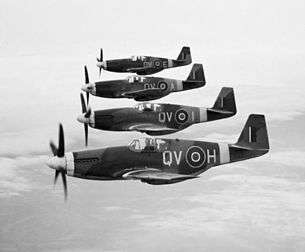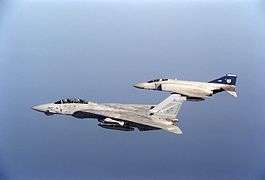No. 19 Squadron RAF
| No. XIX (Reserve) Squadron RAF | |
|---|---|
.png) | |
| Active |
1 Sep 1915 - 31 Dec 1919 1 Apr 1923 - 31 Dec 1976 1 Jan 1977 - 9 Jan 1992 23 Sep 1992 – 24 November 2011 |
| Country |
|
| Branch |
|
| Motto(s) |
Latin:Possunt quia posse videntur (Translation: "They can because they think they can")[1] |
| Battle honours |
Western Front 1916-1918* Somme 1916* Arras Ypres 1917* Somme 1918 Lys Amiens Hindenburg Line Dunkirk* Home Defence 1940-1942 Battle of Britain 1940* Channel and North Sea 1942-1942 Fortress Europe 1942-1944* Dieppe Normandy 1944* Arnhem France and Germany 1944-1945 Honours marked with an asterix(*) are those actually emblazoned on the Squadron Standard[2] |
| Insignia | |
| Squadron Badge heraldry | Between wings elevated and conjoined in base, a dolphin, head downwards.[1][3] |
| Squadron Roundel |
 |
| Squadron Codes |
WZ (Oct 1938 - Sep 1939)[4][5] QV (Sep 1939 - Sep 1945)[6][7] A (1989 - 1991)[8] |
No. 19(F) Squadron RAF (sometimes written as No. XIX Squadron) was a flying squadron of the Royal Air Force.
History
First World War
No. 19 Squadron of the Royal Flying Corps was founded on 1 September 1915[9] training on a variety of aircraft before being deployed to France in July 1916 flying B.E.12s and re-equipping with the more suitable French-built Spads.
From November 1917, the squadron started to receive Sopwith Dolphins to replace its Spads, it being fully equipped with the Dolphin during January 1918, flying its first operational patrol with the new fighter on 3 February.[10] In 1918, the squadron was re-equipped with Sopwith Dolphins, flying escort duties. By the end of the war, 19 Squadron had had a score of flying aces among its ranks, including Albert Desbrisay Carter, John Leacroft, Arthur Bradfield Fairclough, Oliver Bryson, Gordon Budd Irving, Frederick Sowrey, future Air Commodore Patrick Huskinson, Cecil Gardner, Roger Amedee Del'Haye, future Air Chief Marshal James Hardman, Finlay McQuistan, Alexander Pentland, John Candy, Cecil Thompson, John Aldridge,[11] and Wilfred Ernest Young.[12] Commanding officers during this time included H.D. Harvey-Kelly who was the first RFC pilot to land in France in the First World War. At least one of 19 Sqn. fliers, a Canadian, George Robert Long, was captured on 6 October 1917 in the Lille area and spent the rest of the war in a number of POW camps, including Holzminden POW camp. It was his very first flight, in a Spad VII, #B3508. He was shot down by Gefr. J. Funk, flying with Ja30. He had first been a member of the C.E.F. in the infantry and was wounded a number of times. He wasn't repatriated until 14 December 1918, to return home to Ottawa, Ontario, Canada.
Between the World Wars
The Squadron was disbanded after the First World War on 31 December 1919,[13] to be reformed again at RAF Duxford on 1 April 1923.[13] They then flew a number of different fighters, and were the first squadron to be equipped with the Gloster Gauntlet in May 1935, and with the Supermarine Spitfire on 4 August 1938.[14]
World War II

The Squadron was stationed in the UK after the outbreak of the Second World War, and was part of No. 12 Group RAF, RAF Fighter Command, during the Battle of Britain.[15] 19 Squadron formed part of the Duxford Wing, 12 Group's 'Big Wing' formation. Later versions of Spitfires were flown until the arrival of Mustangs for close-support duties in early 1944.[16] After D-Day, No. 19 briefly went across the English Channel before starting long-range escort duties from RAF Peterhead for Coastal Command off the coast of Norway.[17]
Post World War II
In the post-war period, the squadron flew at first de Havilland Hornets and later a variety of jet fighter aircraft including the Hawker Hunter fighter then re-equipping with English Electric Lightning F2 (1962 - 1964) and was based at Royal Air Force Station Leconfield, Yorkshire, as an interceptor squadron within Fighter Command, as part of UK air defence forces.
The Squadron and sister No 92 Squadron were deployed forwards in 1964 to RAF Gütersloh, close to the inner German border, as part of Second Allied Tactical Air Force (2ATAF). Subsequently, the squadron re-equipped with the longer range F2A version.
In 1976, No 19 Sqn, along with No 92 Sqn, disbanded with the Lightning and reformed at RAF Wildenrath,[16] further back west of the Rhine, with the Phantom FGR2 still in the air defence role.
In January 1992, the squadron disbanded as part of agreed post-Cold War force reductions and their aircraft were scrapped.
The numberplate was then assigned to the former No. 63 Squadron, one of the Hawk squadrons at RAF Chivenor, in September 1992. The squadron was a 'Shadow' identity of No. 2 Tactical Weapons Unit (2 TWU). Following the closure of Chivenor to jet flying the squadron was moved to RAF Valley in September 1994 to provide advanced fast jet training on the BAE Hawk.
In May 2008, a Hawk T.1, XX184, was re-painted in a special Spitfire camouflage livery at RAF Valley. This was done to celebrate the 70th anniversary of the squadron as the first operational fighter squadron to fly the Supermarine Spitfire from Duxford in 1938.
Disbandment
As a consequence of the UK's Strategic Defence and Security Review in 2010, the Air Force Board decided in 2011 that 19 Squadron's training role with the Hawk T2 at RAF Valley should be transferred to a resurrected 4(R) Squadron. 19 Squadron, one of the last surviving Battle of Britain Squadrons, disbanded on 24 November 2011, 96 years after it was first formed.[18]
The disbandment event, held at RAF Valley, was led by the Wg Cdr Kevin Marsh, the last Commanding Officer of 19 Squadron. In attendance were the Chief of Air Staff, Air Chief Marshal Sir Stephen Dalton KCB ADC BSc FRAeS CCMI RAF, former Air Chief Marshal Sir William Wratten, GBE, CB, AFC and Flt Lt Ken Wilkinson AE who flew Spitfires in the Battle of Britain on 19 Squadron.
Aircraft operated


| From | To | Aircraft | Version |
|---|---|---|---|
| September 1915 | October 1915 | Farman MF.11 Shorthorn | |
| September 1915 | October 1915 | Avro 504 | |
| September 1915 | October 1915 | Caudron G.3 | |
| October 1915 | December 1915 | Royal Aircraft Factory B.E.2 | c |
| December 1915 | December 1915 | Royal Aircraft Factory R.E.7 | |
| February 1916 | July 1916 | Avro 504 | |
| February 1916 | July 1916 | Caudron G.3 | |
| February 1916 | July 1916 | Bristol Scout | |
| February 1916 | July 1916 | Martinsyde S.1 | |
| February 1916 | July 1916 | Royal Aircraft Factory B.E.2 | c |
| February 1916 | July 1916 | Royal Aircraft Factory F.E.2 | b |
| February 1916 | July 1916 | Royal Aircraft Factory R.E.5 | |
| February 1916 | July 1916 | Royal Aircraft Factory R.E.7 | |
| June 1916 | February 1917 | Royal Aircraft Factory B.E.12 | |
| October 1916 | January 1918 | SPAD S.VII | |
| June 1917 | January 1918 | SPAD S.XIII | |
| November 1917 | February 1919 | Sopwith Dolphin | |
| April 1923 | December 1924 | Sopwith Snipe | |
| December 1924 | April 1928 | Gloster Grebe | |
| March 1928 | September 1931 | Armstrong Whitworth Siskin | Mk.IIIa |
| September 1931 | January 1935 | Bristol Bulldog | Mk.IIa |
| January 1935 | March 1939 | Gloster Gauntlet | Mk.I |
| September 1936 | February 1939 | Gloster Gauntlet | Mk.II |
| August 1938 | December 1940 | Supermarine Spitfire | Mk.I |
| June 1940 | September 1940 | Supermarine Spitfire | Mk.Ib |
| September 1940 | November 1941 | Supermarine Spitfire | Mk.IIa |
| October 1941 | August 1943 | Supermarine Spitfire | Mk.Vb |
| September 1942 | March 1943 | Supermarine Spitfire | Mk.Vc |
| August 1943 | January 1944 | Supermarine Spitfire | Mk.IX |
| January 1944 | April 1945 | North American Mustang | Mk.III (P-51 B/C) |
| April 1945 | March 1946 | North American Mustang | Mk.IV (P-51D) |
| March 1946 | November 1946 | Supermarine Spitfire | LF.16e |
| October 1946 | May 1948 | de Havilland Hornet | F.1 |
| March 1948 | January 1951 | de Havilland Hornet | F.3 |
| January 1951 | June 1951 | Gloster Meteor | F.4 |
| April 1951 | January 1957 | Gloster Meteor | F.8 |
| October 1956 | February 1963 | Hawker Hunter | F.6 |
| November 1962 | October 1969 | English Electric Lightning | F.2 |
| January 1968 | December 1976 | English Electric Lightning | F.2a |
| January 1977 | January 1992 | McDonnell Douglas F-4 Phantom II | FGR.2 |
| September 1992 | November 2011 | BAe Hawk | T.1 / T.2 |
See also
References
- Notes
- 1 2 Palmer 1991, p. 3.
- ↑ Barrass, M. B. (2015). "No. 16–20 Squadron Histories". Air of Authority - A History of RAF Organisation. Retrieved 19 October 2015.
- ↑ "19 Squadron". Royal Air Force. 2015. Retrieved 19 October 2015.
- ↑ Bowyer and Rawlings 1979, p. 11.
- ↑ Flintham and Thomas 2003, p. 52.
- ↑ Bowyer and Rawlings 1979, p. 87.
- ↑ Flintham and Thomas 2003, p. 99.
- ↑ Flintham and Thomas 2003, p. 229.
- ↑ Halley 1988, p. 55.
- ↑ Chorlton Aeroplane Autumn 2014, p. 58.
- ↑ "19 Squadron". The Aerodrome. 2015. Retrieved 19 October 2015.
- ↑ "Wilfred Ernest Young". The Aerodrome. 2015. Retrieved 19 October 2015.
- 1 2 Rawlings 1978, p. 47.
- ↑ Rawlings 1978, p. 48.
- ↑ Rawlings 1978, p. 525.
- 1 2 Halley 1988, p. 56.
- ↑ Rawlings 1978, p. 49.
- ↑ "IV Squadron Reborn". Royal Air Force. 24 November 2011. Retrieved 19 October 2015.
- ↑ Jefford 2001, pp. 33-34.
- ↑ Palmer 1991, pp. 353-374.
- Bibliography
- Bowyer, Michael J.F. and John D.R. Rawlings. Squadron Codes, 1937-56. Bar Hill, Cambridgeshire, UK: Patrick Stephens Ltd., 1979. ISBN 0-85059-364-6.
- Chorlton, Martyn. "The Determined Dolphins". Aeroplane, Autumn 2014, Vol. 42, No. 9. pp. 58–62. ISSN 0143-7240.
- Delve, Ken. The Source Book of the RAF. Shrewsbury, Shropshire, UK: Airlife Publishing, 1994. ISBN 1-85310-451-5.
- Flintham, Vic and Andrew Thomas. Combat Codes: A Full Explanation and Listing of British, Commonwealth and Allied Air Force Unit Codes since 1938. Shrewsbury, Shropshire, UK: Airlife Publishing Ltd., 2003. ISBN 1-84037-281-8.
- Halley, James J. The Squadrons of the Royal Air Force & Commonwealth, 1918-1988. Tonbridge, Kent, UK: Air-Britain (Historians) Ltd., 1988. ISBN 0-85130-164-9.
- Jefford, Wing Commander C.G., MBE, BA, RAF (Retd.). RAF Squadrons, a Comprehensive record of the Movement and Equipment of all RAF Squadrons and their Antecedents since 1912. Shrewsbury, Shropshire, UK: Airlife Publishing, 1988 (second edition 2001). ISBN 1-85310-053-6.
- Palmer, Derek. Fighter Squadron (No. 19). Upton-upon-Severn, Worcestershire, UK: Self Publishing Association, 1991. ISBN 1-85421-075-0.
- Palmer, Derek. 19 Fighter Squadron, RAF. Published by Derek Palmer, 2008. ISBN 978-0-9558970-0-9.
- Rawlings, John D.R. Fighter Squadrons of the Royal Air Force and their Aircraft. London: MacDonald and Jane's (Publishers) Ltd., 1969 (new edition 1976, reprinted 1978). ISBN 0-354-01028-X. pp. 47–54.
External links
| Wikimedia Commons has media related to No. 19 Squadron RAF. |
